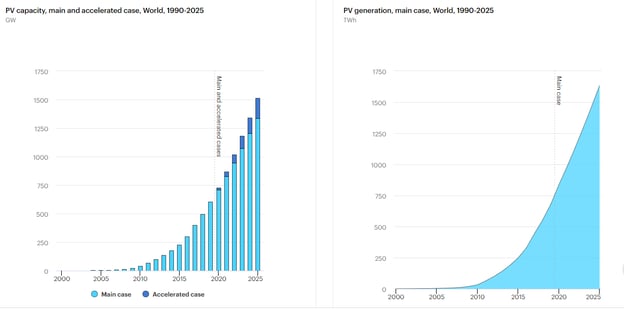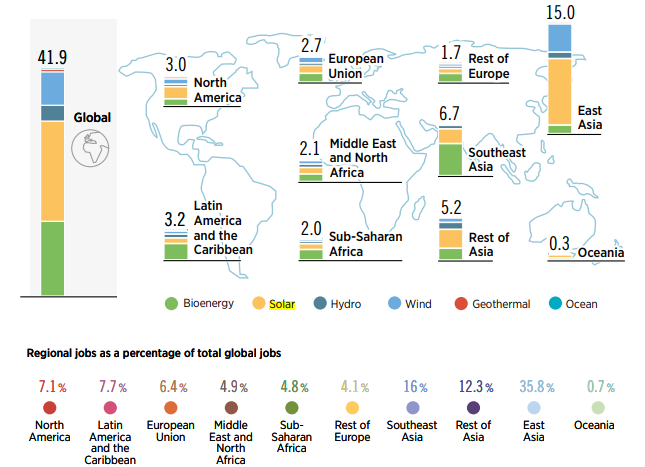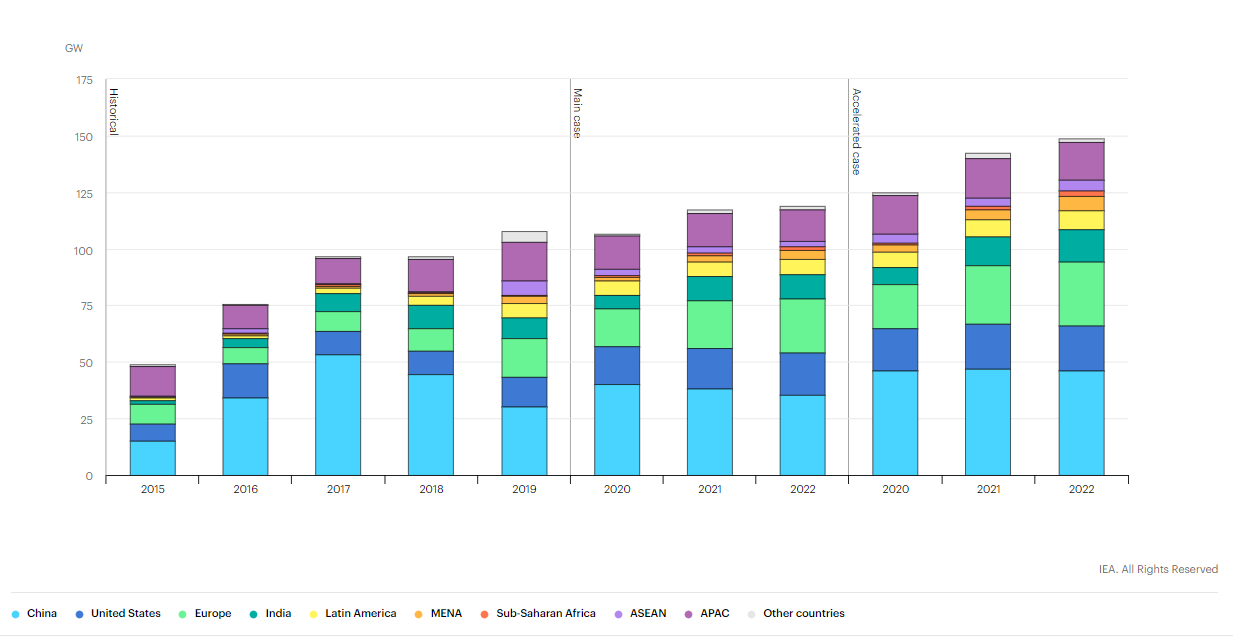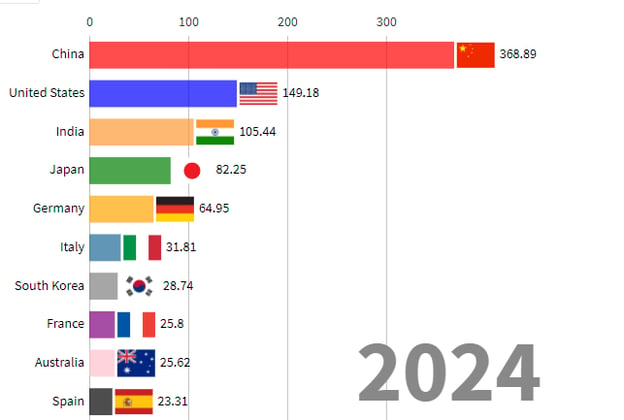
By
Nana Terra
March 4, 2021
Updated
September 12, 2023
Source: Saravutpics/Shutterstock
Many countries are increasing green energy investment in order to reduce dependence on fossil fuels. Concerns about the environment and electricity costs are driving the fast growth of the solar and wind sector.
Solar energy has grown more than 10-fold in the past decade, from just 43.7GW of capacity in 2010 to 651GW at the end of 2019, and it is still increasing. Between 2020 to 2030, the sector will grow by an average of 13% per year, meeting almost one-third of electricity demand growth over the period.
According to the Renewable 2020 Report, by International Energy Agency, despite the Covid-19 pandemic, significant markets, such as China, the United States, and the European Union, will help solar photovoltaics (PV) energy add an average of over 125 GW of capacity per year from 2021-2025.
 Figure 1: PV capacity and PV generation between 1990-2025. Source: Renewable 2020 Report, IEA
Figure 1: PV capacity and PV generation between 1990-2025. Source: Renewable 2020 Report, IEA
Solar jobs in demand globally
About 42 million people will work in manufacturing, installing, operating and maintaining renewable energy systems in 2050. Most of these roles will be created in solar energy, which would account for almost half of these jobs, followed by bioenergy and wind energy.
- Asia will be the largest creator of global renewable energy jobs. East Asia alone will provide 36% of jobs and the rest of Asia will contribute 28%. The Americas will produce 15% of global jobs and Europe will add 10%.
- Construction, factory workers, and technicians will hold a 77% share of employed occupations in renewable energy.

Figure 2: An estimated 42 million jobs in renewables: regional distribution. Source: IRENA, 2020.
Which countries are leading the way in solar energy?
Many countries have shown a commitment to generating more environmentally-friendly energy in recent years.
They are investing heavily in renewable solar power, funding great projects and encouraging consumers to make heavier use of panels in their home environments.

Figure 3: Solar PV net capacity additions by country and region, 2015-2022. Source: Data and statistics IEA
Here are five countries leading the way in solar energy adoption:
China

China is leading in the global solar race. The nation already has more solar capacity than any other country in the world, at a gargantuan around 130 GW and it is home to several solar farms, including the world’s largest in the Tengger Desert.
According to the market intelligence business Wood Mackenzie, China’s photovoltaic panel installations will hit a cumulative total of 370 GW by 2024
The drastic increase in solar power in recent years is a result of many factors, such as the nation’s need for electricity, its severe air pollution crisis and the aggressively encouraging financial institutions to give incentives for solar installations. China is also the world’s largest manufacturer of solar panels.
United States of America

The United States is the second-largest growth market for renewables. Since 2008, installations of solar power systems have grown 35-fold to an estimated 62.5 GW today.
This is enough capacity to power the equivalent of 12 million average American homes.
Markets for solar energy are increasing fast. States have implemented various policies to support the use of solar power, resulting in more and more solar PV installations across the country.
Home to some of the world’s largest solar power plants, the US has more than 242,000 solar workers and 237 solar projects are slated for the next 5 years with a total value of $58bn.
Japan

More and more Japanese cities are using distributed energy and microgrids to restructure their energy infrastructure.
According to Irena, Japan is the third-largest solar market with 62GW in terms of total installed solar PV capacity in the world.
The country is also a leader in manufacturing the technology needed to build solar panels.
Nagasaki and Miyagi are the regions investing the most in solar power projects over the next 5 years.
Germany

Germany has been a leader in solar power for several years. In late 2010, the country initiated the Energiewende, a major plan for transforming its energy system into an efficient one supplied mainly by renewable energy sources.
They are on track for 80% of total energy consumption to come from renewable sources.
Solar energy is the second-largest renewable energy source and the most ubiquitous across the country. Germany remains Europe's largest solar market, despite projections that its share will decrease in the coming years.
India

With a population of 1.36 billion, India has seen energy demand increasing rapidly. The Government of India has made remarkable progress, achieving an initial target of 20 GW capacity for 2022, four years ahead of schedule in 2018.
India’s solar installed capacity reached 34,62GW in 2020 and the country became the lowest cost producer of solar power in the world. In the coming years, 90 projects are scheduled to begin with a total investment value of $81 bn.

Figure 4: Cumulative annual PV installations by country, 2001 - 2024E (GWdc). Source: Market Intelligence Business Wood Mackenzie
How can Airswift help
Airswift is committed to a sustainable future. We work on several energy transition projects and have a dedicated team of specialist recruiters in renewable disciplines. That is the reason why we are the agency of choice for world-leading renewable energy businesses.
With over 60 offices worldwide, 1,000 employees, and 9,000 contractors, we help companies of all sizes find the talent they need and help candidates find the best opportunities. We are already working with many of the key renewable companies and also with candidates from other engineering sectors, who are looking to make the transition into Renewables.
So if you are a renewable energy professional ready for a career change and are looking for your next role in this sector, contact us.

